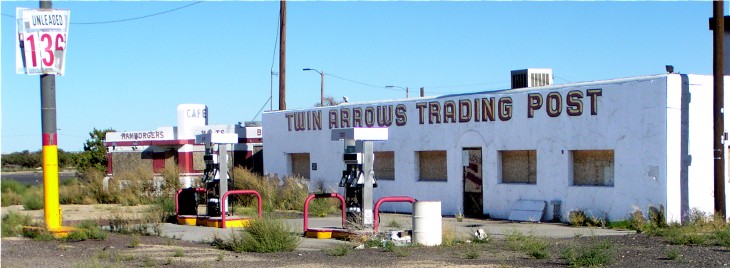| Bankruptcy & Debt Information | Around ARIZONA Home |
 |
| The sign at the abandoned Twin Arrows Trading Post still advertised unleaded gas at $1.369/gallon in 2003. 9-03. |
Best "Little" Stop on I-40. A weathered
billboard near the Twin Arrows Road exit describes Twin Arrows as Twin Arrows came into being sometime after Jack D Rittenhouse put together his 1946 edition of A Guide Book to Highway 66 which does not list Twin Arrows, but before Interstate 40 bypassed the old road in 1970's. The Interstate afforded the trading post its own exit on a small remaining stretch of 66 which allowed it to operate it into this millennium. Guidebook descriptions. Michael Wallis devotes half of a paragraph to describe the Twin Arrows Trading Post in his 1990 edition of Route 66, The Mother Road. He says, "Twin Arrows has the look and feel of an old wayside business along the highway. Inside the small eight-stool diner, fry cooks serve up good road grub--steak and eggs and hash browns--despite a joke menu that talks about buzzard eggs, fried pack-rat tail, sagebrush coffee, roasted jack-rabbit ears, meteor crater stew, braised rattlesnake hips, sautéed centipede legs, prickly-pear pie, and lizard tongue pudding." The remains of that diner can be seen to the left of the trading post in the top picture on this page.
Twin Arrows was still operating at the turn of the century. Nick Freeth's Route 66 Main Street USA, published in 2001, has a one sentence description of the little stop, "The diner here serves classic American road food, and is especially popular with truckers." Valentine Diner. According to the Kansas State Historical Society, there are seven remaining Valentine Diners in Arizona, three of which are along Route 66 including one at the Twin Arrows trading post. The Valentine Diner was born of the depression era in Wichita, Kansas (which explains the Kansas historical society's interest). Arthur Valentine operated dozens of lunchrooms in central Kansas in the 1920's and 30's. He had the lunchrooms built by an equipment company and then delivered intact to their final locations. As metal became plentiful at the end of World War II, Arthur acquired a manufacturing company and began selling the prefabricated diners across the nation as the "Golden Opportunity for Your Golden Future." The little restaurants were delivered fully equipped on a flatbed trailer for about $5,000. If the new restaurant owner financed his purchase, he would deposit a percentage of his sales receipts to make up a payment of about $40/month into a safe near the restaurant's entrance for the Valentine agent to pick up. If the receipts were not deposited as agreed, the flatbed truck would return to the site and pick up the restaurant.
Inspired sign-making. The Twin Arrows Trading Post is a case of inspired sign-making. For a modest investment in a couple of telephone poles planted at an angle to form a shaft, and some trim pieces to replicate the arrowhead and feathered tail sections, the clever entrepreneur had an eye-catching monument of enormous proportions. Not only did the arrows snag decades of travelers along the old road, they managed to make the cover of at least one Route 66 guide book.
|
|||||||
|
|
|||||||
|
|||||||